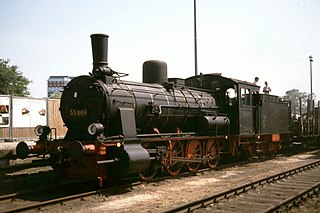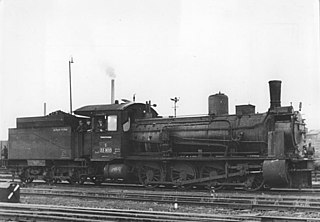
The Prussian Class P 8 of the Prussian state railways was a 4-6-0 steam locomotive built from 1906 to 1923 by the Berliner Maschinenbau and twelve other German factories. The design was created by Robert Garbe. It was intended as a successor to the Prussian P 6, which was regarded as unsatisfactory.

The first steam locomotives of the Baden Class VI c were delivered in 1914 by the Maschinenbau-Gesellschaft Karlsruhe for service in southwestern Germany with the Grand Duchy of Baden State Railway.
The Alsace-Lorraine Class G 8.1 was a superheated, goods train, steam locomotive with four driving axles, and was based on the Prussian G 8.1. There were no design differences between the two. The Imperial Railways in Alsace-Lorraine received a total of 137 G 8.1 engines between 1913 and 1919, of which eleven were built by Henschel and the rest by the Grafenstaden. They were numbered 5151 to 5278.
The Oldenburg G 4.2 steam locomotives were goods train engines built for the Grand Duchy of Oldenburg State Railways between 1895 and 1909 in several series.

The Prussian T 16.1 locomotives were built for the Prussian state railways as goods train tank locomotives about the time of the First World War. Six examples were also procured by the Imperial Railways in Alsace-Lorraine.
The Prussian Class G 4 were German, six-coupled, goods train, steam locomotives with a boiler pressure of 12 bar, built primarily for the Prussian state railways. Classified by the state railway in 1905, they included 16 locomotives from the railway division of Mainz, that originally came from the Hessian Ludwigsbahn. These earlier locomotives were delivered between 1872 and 1896 and did not meet the Prussian norms.

The Prussian Class T 11 were passenger tank locomotives produced between 1903 and 1910 in the service of the Prussian state railways for duties on the Berlin Stadtbahn.

The Prussian Class T 10s were tank locomotives operated by the Prussian state railways. They were procured for duties between Frankfurt and Wiesbaden between 1909 and 1912. This 41-kilometre (25 mi) long route between the two termini was to be worked without turning the locomotive. Because the engine tended to derail, in practice it was turned whenever possible. On these engines, supplied by Borsig, the boiler from the Prussian P 6 and the running gear and drive from the Prussian P 8 were used. The boiler had to be positioned further forward than was usual on other locomotives in order to even out the distribution of weight, because the design omitted any trailing wheels. The first trial runs took place on 30 June 1909.

The Prussian Class G 7.1 engines of the Prussian state railways were German eight-coupled, goods train, steam locomotives.

The Saxon Class XI T were German, 0-10-0, tank locomotives with the Royal Saxon State Railways procured for goods train services. The Deutsche Reichsbahn grouped them in 1925 into their DRG Class 94.19-21.
The Prussian G 8.2 class of locomotives actually incorporated two different locomotive types: one was the Prussian/Oldenburg G 8.2, for which the Deutsche Reichsbahn subsequently issued follow-on orders; the other was the G 8.2 of the Lübeck-Büchen Railway.
The Prussian Class G 5.1 steam engines were the first 2-6-0 goods locomotives in Europe. They were developed for the Prussian state railways from the Class G 4 and a total of no less than 264 units of this class were placed in service in Prussia between 1892 and 1902. The twin-cylinder G 5.1 had been designed to raise the speed of goods trains on main lines. In addition, more powerful engines were needed for the increasingly heavy train loads. The locomotives, which were equipped with a compressed air brake, were used in charge of fast goods trains (Eilgüterzugdienst) and also passenger trains due to their impressive top speed of 65 km/h. The G 5.1 was fitted with inside Allan valve gear and the carrying wheels were of the Adams axle design. The engines were coupled with tenders of Class pr 3 T 12. In Prussian service they were renumbered in 1905 into the 4001–4150 range.

The Prussian Class T 12 is an early, German, passenger train, tank locomotive built for the Prussian state railways in large numbers. These locomotives were superheated variants of the T 11.

The Prussian T16 locomotives were ten-coupled superheated freight tank locomotives of the Prussian State Railways. They were later renumbered in the 94.2–4 by Deutsche Reichsbahn
The Prussian G 12 CFOA-type variant was a class of German 2-10-0 locomotives used by the Prussian state railways. The locomotives of this type were originally an order from the Ottoman Ministry of War, and fifteen examples were intended for the Chemins de fer Ottomans d'Anatolie (CFOA). Due to the course of the war, only five locomotives could initially be delivered by Henschel to the CFOA. The other five locomotives went to the German Military Railways with the consent of the customer. The were assigned to the Military Directorate General in Brussles as G 12 numbers 5551 to 5555. To replace these five locomotives, Henschel delivered another five locomotives to the CFOA in 1918. The remaining five locomotives ordered for the Ottoman Empire were not made.

The Prussian G 7.2 was a class of 0-8-0 tender compound locomotives of the Prussian state railways. In the 1925 Deutschen Reichsbahn renumbering plan, the former Prussian locomotives produced from 1895 to 1911 were given the class designation 55.7–13; while the former Grand Duchy of Mecklenburg Friedrich-Franz Railway locomotives were classified as 55.57.
The Prussian G 5.3 was a class of 2-6-0 goods locomotives. They were the two-cylinder-simple version of the compound G 5.4. As with many Prussian locomotive design, simple and compound versions of the same type built. The G 5.3, like the G 5.4, differed from the G 5.1 and G 5.2 as it had a shorter wheelbase and a higher-pitched boiler. The Krauss-Helmholtz bogie was intended to improve the driving characteristics, especially at higher speeds. Production of the G 5.3 was from 1903 until 1906, and 206 units were built.
The Prussian G 5.2 was a class of two-cylinder compound goods locomotive introduced in 1895. As with many Prussian locomotive design, simple and compound versions of the same type were built – in this case the G 5.2 was the two-cylinder compound version of the simple G 5.1. The compound locomotives were more economical and more powerful than the simple locomotives; they were more suitable for long streches with few stops. The newly introduced air brakes made it possible to use the G 5.2 on passenger trains, which the Prussian State Railways often did.
The Prussian G 4.2 was a class of compound 0-6-0 goods locomotive of the Prussian State Railways. It was a compound version of the G 3 and G 4.1 types by Henschel.









